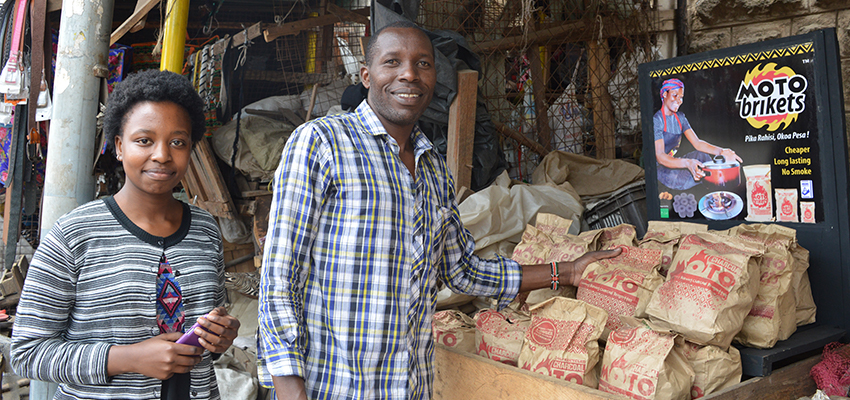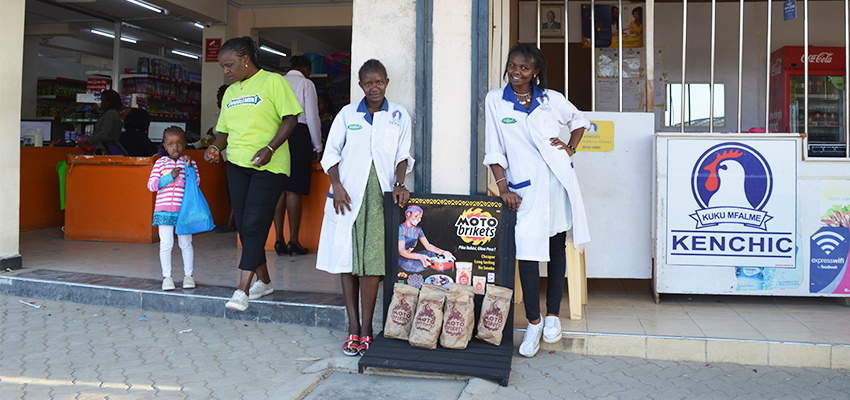
"In any social enterprise there will be a tension between profit and impact – it’s about balancing that tension and finding a middle ground, without entirely sacrificing either profit or purpose – to achieve sustainable change."
Just beyond the veranda of the BrightGreen Renewable Energy office, the whirring sound from the building across rows of drying briquettes slows to a stop, signaling that production has ended for the day. The team carries out a tray of shiny-wet briquettes and leaves them in the sun to dry as Moses, who makes BrightGreen’s deliveries, heaves the last sack of briquettes into the hatchback serving as the company’s delivery vehicle. “Let’s go!” he calls across the rows of drying briquettes, waving me over. I squeeze into the backseat next to a stack of painted wooden display shelves, and we pull out of the gate to the sound of upbeat Kenyan music.
We’re on our way to visit some of BrightGreen’s distributors, who sell the MOTO briquettes from kiosks and small shops throughout Nairobi. The initial research I had done as a Monitoring and Evaluation Fellow through the MIT D-Lab Scale-Ups Fellowship confirmed just how important these distributors were to BrightGreen’s go-to-market strategy, and we were providing marketing support in the form of wooden display shelves to help increase visibility for potential customers. At the same time, we were leaving sign-up sheets for customers to leave their phone numbers, allowing us to contact them and collect user feedback. Although key for assessing the impact of the product, BrightGreen did not yet have a system to keep track of end users – leaving us wondering about data such as the number of customers BrightGreen actually had and what impact the briquettes had on their lives.
The Problem
A social enterprise whose CEO Chebet Lesan was a 2017 D-Lab Scale-Ups Fellow, BrightGreen manufactures charcoal briquettes for cookstoves out of agricultural waste. Currently, over 80% of Kenyans – or approximately 36 million people – use firewood or wood charcoal as their main source of cooking fuel. This has devastating consequences for the environment and users’ health. The World Health Organization estimates that “3.8 million people a year die prematurely from illness attributable to household air pollution.” Women, who in Kenya are typically responsible for household cooking, are disproportionately affected. As trees become more scarce, the price of wood charcoal has also increased – a recent government ban on producing wood charcoal caused prices to rise 34% over the past year alone - meaning that many low-income families in Kenya are struggling to afford cooking fuel.
BrightGreen has been tackling these issues by providing an alternative to traditional firewood and wood charcoal. Compatible with users' current stoves, BrightGreen’s briquettes are made from agricultural waste and burn longer, release less smoke, and cost less than traditional charcoal. BrightGreen calculated that the product saves an estimated 638 hectares of forest are saved per year – assuming that the briquettes are replacing wood charcoal, which was one of the many hypotheses I intended to test this summer.
The Kiosks
As an M&E Fellow, I was there to help BrightGreen set up systems to track impact data while also gathering feedback to improve the product and other aspects of the business, such as distribution. I started with the kiosk owners, who were key players in BrightGreen’s distribution chain. Few companies in Kenya manufacture eco-friendly briquettes. Fewer still ensure that these reach customers at the “base of the pyramid” – low-income household users – where the briquettes could potentially have the greatest impact.

BrightGreen still makes most of its sales to industrial clients, who use the briquettes for cooking and warming (Nairobi, at an elevation of 5,889 ft, can be surprisingly cold at times of the year!). However, a portion of BrightGreen’s sales are reserved for low-income households, who shop at kiosks, rather than grocery stores, and would find it difficult to afford the 1,000 or 1,600 KES ($10 or $16) price tag on BrightGreen’s 25 or 50kg bags. Since February, BrightGreen has been piloting a program to reach these customers through women kiosk owners, who receive the briquettes at a discounted price and are provided training on key selling points and benefits. One of BrightGreen’s key differentiators for this target segment is its packaging – instead of the typical open tins, filled with cement, sticks, and other impure material, the briquettes are sealed in small 1kg & 2kg paper bags – packaging that is catchy, clean, and honestly weighed.
It was now time to track the effectiveness of the low-income product sales, and though we kept interviews open-ended to begin with, we focused on answering three key questions: 1) Were the briquettes effective and did customers like using them? 2) Were customers saving money? And 3) Was BrightGreen actually reaching the poor?
Data Collection
I started by interviewing both kiosk owners and BrightGreen’s industrial clients and other distributors, both over the phone and in-person. The first thing we learned was that many large-scale users were dissatisfied with the pricing. In an effort to ensure that the low-income customers could afford the briquettes, BrightGreen had made the prices of the 1kg & 2kg packages lower than the larger quantity packages, essentially using the profits from industrial sales to subsidize the low-income target client segment. Although this didn’t seem to be affecting sales, many clients felt that this was fundamentally unfair and we realized it could become an issue as BrightGreen scaled. In addition, this stressed the need for us to confirm that the individual packages were actually reaching the poor, as intended.
The second was around BrightGreen’s marketing. More customers were coming through the website and social media than we had suspected, and distributors said they would love to have videos and other resources to share online. Though there was extremely positive feedback around the packaging, many shopkeepers said that customers who had never seen charcoal packaged in that way were initially confused, and thought the product was food. When we visited the kiosks in-person, we realized that the briquettes were sometimes simply tossed on bottom shelves wherever there was room, and that there was nothing to draw attention to what the product was. It was striking to see other branded display items provided by more mainstream companies such as soda and candy manufacturers, and we realized that BrightGreen would need to do more to obtain equal visibility.
When it came time to survey the low-income customers, we knew that one of the biggest challenges would be obtaining customers’ contact information. In particular, we needed to find a system that would be cost-effective for a startup that was trying to stay lean. I experimented with printing a unique code that would be left inside each bag, so customers could text BrightGreen for a survey and receive 20 cents in phone credit in return. While we waited for these to reach customers, the production team and I built a number of display shelves with a BrightGreen poster featuring a woman holding a cooking pot over briquette-filled cookstove, which would explain visually what was in the paper bags. We distributed these to the kiosk owners along with sign-up sheets to collect end user phone numbers, and asked if they could provide any off-hand for us to do a survey. The distributors happily complied, and we were surprised by how quickly we had customer numbers that we could begin calling.
The final aspect of the survey for end customers was to learn whether they were truly low-income, and if the cost savings we provided through the briquettes were significant. To establish this, I used the Poverty Probability Index (PPI), a survey tool developed by the Grameen Foundation that allows users to ask a series of 10 country-specific questions, the answers to which establish the percentage likelihood that a given survey respondent is living under the poverty line. By the end of the summer, we had finished administering the survey to just over 20 customers. Though the sample size was not large enough to be statistically significant, the responses suggested that approximately 47% of BrightGreen’s 1kg and 2kg customers were likely to be living on $8/day or less. Customers were saving anywhere between 100 KES ($1) and 1,000 KES ($10) week, which would have a significant impact for a low-income family.

Lessons Learned and Takeaways
The feedback we received from customers and distributors alike over the course of the summer was invaluable to BrightGreen’s operations, and helped inform priorities from the briquette manufacturing itself to marketing and distribution operations. As important as it was to speak directly with end users, some of the most helpful information we received came from talking to the kiosk owners and keeping a pulse on the business through them. In the informal economy, I realized, sales tend to be personal – shopkeepers know their customers well, and it was often thanks to them that customers had decided to try the briquettes in the first place.
On the other hand, working with low-income kiosk distributors could be expensive and time-consuming. Items such as the shelves, posters, business cards, and free samples that BrightGreen provided to these kiosk owners could add up, and the price differentiation between the 1kg & 2kg packets and the 25kg & 50kg sacks was already a point of contention for customers. One option BrightGreen is considering is partnering with an organization focused on getting life-improving products to last-mile customers – a solution that would allow the company to stay focused on manufacturing rather than distribution. In the meantime, however, BrightGreen is committed to reaching the users who could benefit from the product the most, even if that means making business trade-offs.
In any social enterprise there will be a tension between profit and impact – it’s about balancing that tension and finding a middle ground, without entirely sacrificing either profit or purpose – to achieve sustainable change.
Erika Desmond is a startup and development consultant focused on social enterprises. She was previously the co-chair of Boston+Acumen, a self-organized, volunteer-led chapter of Acumen, and has worked in business development at a tech startup in Boston and as a Fulbright English Teaching Assistant in Austria.

